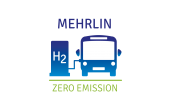The projects JIVE and MEHRLIN run in parallel and work in close cooperation. The key objective of JIVE is to implement and operate of 139 zero emission fuel cell bus-es in five EU member states at unprecedented scale, thereby advancing their com-mercialisation. The main objective of MEHRLIN is to promote, deploy and commer-cialise hydrogen as an alternative fuel, contributing to the European alternative fuel implementation strategy. This includes operating real-pilot hydrogen refuelling sta-tions at seven locations along four Core Network Corridors of the trans-European Transport Network (TEN-T).
Most of the buses co-funded under JIVE will refuel at stations co-funded under MEHRLIN. Both projects involve analysis tasks based on data collected during the demonstration phase. In this respect, JIVE concentrates on the technical perfor-mance of the stations and buses, while MEHRLIN focuses on the financial aspects of refuelling station ownership and operation, in particular achieving bankability.
To be able to monitor and assess to which degree targets are achieved, operating data need to be collected, compiled, and evaluated on a steady and coherent basis. This Performance Assessment Handbook is the basis of all monitoring and analysis activities of Task 3.1 in JIVE and Activities 2.4, 3.1 and 3.2 in MEHRLIN. It thus:
- Defines the performance indicators for assessing hydrogen infrastructure and fuel cell bus performance, also in comparison to reference technology (buses with in-ternal combustion engines) as well as to those of other novel drivetrains (notably long range electric buses).
- Defines the descriptive parameters and data points required to calculate indicator figures.
- Explains the frequency of data collection and related details.
- Determines the necessary data structures and formats.
- Defines roles and responsibilities for data collection and performance evaluation.
- The descriptive parameters characterise the deployed hardware, such as the nom-inal pressure and efficiency of an electrolyser etc. They are usually collected once.
- The data points are the items to be monitored during demonstration. The operating data are collected at the data points. They are recorded regularly, typically daily (e.g. the distance travelled by a bus) or per event (the amount of hydrogen refu-elled to a bus).
- The performance indicator values are calculated using the operating data and se-lected descriptive parameters.
Key Performance Indicators are subsets from the complete lists of bus and infrastruc-ture performance indicators. For the Key Performance Indicators, the work pro-grammes of the two projects state target figures, such as a minimum efficiency of on-site hydrogen generation and a maximum hydrogen consumption of the buses per 100 km travelled.






